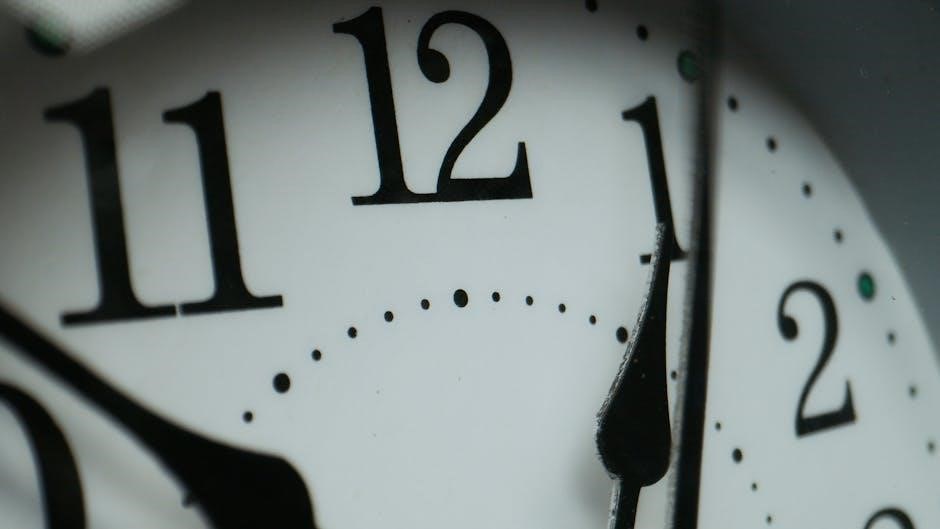Precision radio-controlled clocks use atomic clock signals for accurate timekeeping. They automatically synchronize with signals like WWVB, MSF, or DCF, ensuring reliability and eliminating manual adjustments. These clocks often feature additional functions such as thermometers, calendars, and 12/24-hour displays, making them versatile and user-friendly. Ideal for home or office use, they provide trouble-free time management and are energy-efficient, relying on battery power. Their ability to automatically adjust for daylight saving time and time zones enhances convenience, making them a modern solution for precise timekeeping needs.
1.1 What Is a Radio-Controlled Clock?
A radio-controlled clock is a timekeeping device that synchronizes with atomic clock signals, ensuring high accuracy. It receives signals from transmitters like WWVB, MSF, or DCF, automatically adjusting to the correct time. These clocks often feature manual overrides, time zone corrections, and daylight saving adjustments. They may include additional functions such as thermometers, calendars, and alarms. Battery-operated, they start searching for signals upon battery installation, typically taking 3-12 minutes to synchronize. This technology provides reliable, low-maintenance timekeeping for homes and offices.
1.2 Importance of Precision Timekeeping
Precision timekeeping is essential for modern life, ensuring synchronization across devices and systems. Radio-controlled clocks offer atomic accuracy, eliminating manual errors and maintaining consistent time display. This reliability is crucial for scheduling, technology integration, and daily routines. Accurate timekeeping also supports global communication and resource management, minimizing delays and enhancing productivity. With features like automatic daylight saving adjustments and time zone corrections, these clocks simplify time management, making them indispensable for both personal and professional environments.
1.3 Brief History of Radio-Controlled Technology
Radio-controlled technology emerged in the mid-20th century, with atomic clocks pioneering precise timekeeping. The first signals, like WWVB, began in 1954, enabling synchronization. By the 1970s, consumer devices integrated this tech, revolutionizing time accuracy. Modern clocks now automatically adjust, ensuring reliability and convenience, making radio-controlled timekeeping indispensable for everyday use.
Understanding the Components of a Radio-Controlled Clock
A radio-controlled clock consists of a receiver, atomic clock signal decoder, and display mechanism. The receiver captures time signals, ensuring synchronization with atomic clocks for precision. The display shows the time and often additional data like date or temperature, enhancing functionality. These components work together to provide accurate, maintenance-free timekeeping, making radio-controlled clocks highly reliable and user-friendly devices for everyday use.
2.1 The Receiver and Its Function
The receiver in a radio-controlled clock is a critical component that captures time signals broadcasted at specific frequencies, such as 60 kHz. It uses a built-in antenna to detect these signals, which are transmitted from atomic clocks. Once received, the receiver decodes the time data and synchronizes the clock’s internal mechanism. This process ensures high accuracy and automatic adjustments for daylight saving time or time zones. The receiver operates quietly in the background, periodically checking for signal updates to maintain precise timekeeping. Its reliability and efficiency make it a cornerstone of radio-controlled clock technology.
2.2 The Role of the Atomic Clock Signal
The atomic clock signal is the backbone of radio-controlled clocks, providing highly accurate timekeeping. Broadcasted from locations like Boulder, Colorado (WWVB), Rugby, UK (MSF), and Frankfurt, Germany (DCF), these signals are generated by cesium atomic clocks, ensuring exceptional precision. The signal contains time data, including hours, minutes, seconds, and date, which the clock decodes. This eliminates manual setting errors and adjusts automatically for daylight saving time and time zones. The signal’s reliability and global reach enable clocks to maintain synchronization, making atomic clock signals indispensable for precise timekeeping worldwide.
2.3 The Display and Timekeeping Mechanism
The display and timekeeping mechanism ensure accurate and clear time presentation. Modern radio-controlled clocks feature LCD or LED screens, showing time, date, and sometimes temperature. The internal gears and motors adjust automatically based on received signals, eliminating manual errors. The clock processes time data from atomic signals, updating its display precisely. Some models offer 12/24-hour formats and calendar views. The mechanism also handles daylight saving adjustments and time zone corrections, ensuring the clock remains accurate and user-friendly. This integration of advanced technology and intuitive design makes radio-controlled clocks reliable for everyday use.

Installation and Setup Instructions
Insert batteries, press the manual setting tab, and wait for signal reception. The clock will automatically sync with atomic signals, ensuring precise timekeeping and easy setup.
3.1 Battery Installation
Install 1 AA battery or 2 AAA batteries, ensuring correct polarization. Open the battery compartment, usually located on the back, and insert the batteries as indicated. Close the compartment securely. The clock will reset to 12:00 and begin searching for the radio signal. Allow 5-10 minutes for the initial signal reception. Proper battery installation ensures the clock operates smoothly and maintains precise timekeeping. Refer to the manual for specific battery requirements and compartment location. Battery life typically lasts up to 12 months under normal usage conditions. Always use fresh batteries for optimal performance.
3.2 Initial Setup and Signal Reception
After battery installation, the clock will reset to 12:00 and begin searching for the radio signal. Place the clock upright in an open area, preferably near a window, to ensure optimal signal reception. The initial signal search may take 5-10 minutes. During this time, avoid moving the clock. Once the signal is received, the clock will automatically set the correct time and date. If no signal is found, the clock will continue searching periodically. For areas with weak signals, reception may take longer or require repositioning the clock. Patience is key for successful initial setup.
3.3 Manual Time Setting
If the clock fails to receive the signal, manual time setting is necessary. Remove the battery and locate the manual setting tab on the back. Press this tab 15 times to reset the mechanism. Reinsert the battery, and the clock will reset to 12:00. Use the hour and minute hands to set the correct time manually. Ensure accurate alignment to avoid timekeeping errors. Once set, the clock will resume its normal operation. This method is a reliable backup when signal reception is unavailable, ensuring the clock remains functional and accurate. Always follow this procedure carefully to maintain time precision.

Receiving the Time Signal
The clock automatically searches for a time signal, taking 3-12 minutes for initial reception. It attempts to sync 12 times daily, ensuring accurate timekeeping consistently.
4.1 How the Clock Receives the Signal
The clock features an internal receiver that captures a 60 kHz time signal from atomic clocks, such as WWVB, MSF, or DCF. Upon battery insertion, it automatically searches for the signal, typically taking 3-12 minutes. The receiver decodes the time code, synchronizing the clock’s hands to the exact time. For optimal reception, placing the clock upright in an open area is recommended. Once synchronized, the clock periodically updates to maintain accuracy, ensuring reliable timekeeping without manual adjustments.
4.2 Signal Strength and Reception Issues
Signal strength can vary based on proximity to the transmitter and environmental factors. Physical obstructions, electromagnetic interference, or distance from the signal source may weaken reception. In areas with poor coverage, the clock might fail to receive the signal, leading to incomplete time updates. If signal strength is consistently weak, manual time setting may be necessary. Ensure the clock is placed in an open area for optimal reception. Persistent issues may require relocating the clock or checking for interference from nearby electronic devices.
4.3 Time Required for Initial Signal Reception
The clock typically requires 3 to 12 minutes to receive the initial signal. After inserting the battery, it automatically starts searching for the time signal. In some cases, it may take up to 24 hours for the clock to fully synchronize, especially in areas with weak signal strength. Placement in an upright position and away from obstructions can improve reception speed. If the clock fails to receive the signal within the expected timeframe, check for interference or try relocating it to an area with better signal coverage.

Manual Time Setting Instructions
For manual setting, remove the battery, press the manual setting tab 15 times, and reinsert the battery. The clock will reset to 12:00 and search for the signal.
5.1 Removing the Battery
Begin by removing the battery from the clock to initiate manual time setting. Locate the battery compartment, usually found on the back of the clock. Open the compartment by sliding it downwards or pressing the release tab, depending on the model. Carefully pull out the battery, ensuring no residual power remains. This step is crucial to reset the clock’s internal mechanisms, allowing it to restart the synchronization process. Once removed, the clock will stop functioning, preparing it for manual adjustments. Always handle batteries safely, avoiding improper disposal.
5.2 Pressing the Manual Setting Tab
After removing the battery, locate the manual setting tab on the back of the clock. Press this tab 15 times to reset the clock’s internal mechanisms. This step ensures the clock’s hands reset to the 12 o’clock position, preparing it for accurate time synchronization. Press the tab gently but firmly to avoid damaging the internal components. Once completed, the clock will be ready to reinsert the battery and receive the atomic clock signal. This process ensures the clock’s hands align correctly before automatic synchronization begins. Always follow this step carefully to maintain precise timekeeping functionality.
5.3 Reinserting the Battery
After pressing the manual setting tab, carefully reinsert the battery into the clock, ensuring correct polarization as indicated on the battery compartment. Once the battery is properly seated, the clock will reset to 12:00 and begin searching for the atomic clock signal. This process may take a few minutes, depending on signal strength. The clock’s hands will automatically adjust to the correct time once synchronization is complete. Ensure the clock is placed in an upright position for optimal signal reception. Avoid interrupting the process to allow proper synchronization and accurate time display. Patience is key for precise timekeeping.

Understanding the Time Signal Transmission
Precision radio-controlled clocks receive atomic clock signals like WWVB, MSF, and DCF, transmitted at specific frequencies. These signals ensure accurate time synchronization, with the clock decoding and adjusting accordingly.
6.1 The WWVB Signal
The WWVB signal is broadcast by the National Institute of Standards and Technology (NIST) in Boulder, Colorado. Operating at 60 kHz, it provides precise time information across North America. The signal includes time codes, leap second announcements, and daylight saving time indicators. Radio-controlled clocks decode this signal to synchronize their time accurately. WWVB’s coverage area extends across the contiguous United States, ensuring reliable reception for millions of devices. This signal is a cornerstone of modern timekeeping, enabling seamless synchronization and maintaining high accuracy for various applications.
6.2 The MSF Signal
The MSF signal, operated by the UK’s National Physical Laboratory, broadcasts at 60 kHz from Anthorn, Cumbria. It provides accurate time and date information for radio-controlled clocks across the UK and parts of Europe. The signal includes time codes, leap second data, and daylight saving time updates. MSF’s transmission ensures precise synchronization for devices within its coverage area. Though it was discontinued in 2024, its historical role was crucial for reliable timekeeping in Europe. Users in regions formerly served by MSF should check compatibility with alternative signals like DCF for continued accuracy.
6.3 The DCF Signal
The DCF signal, transmitted from Frankfurt, Germany, operates at 77.5 kHz and is a primary time reference for Central Europe. It provides precise time and date data, including leap seconds and daylight saving time changes. DCF signals are decoded by radio-controlled clocks to synchronize time accurately. The signal’s coverage spans multiple European countries, ensuring reliable timekeeping. Users in this region benefit from its accuracy and consistency, making it a cornerstone for precise clock synchronization in Europe, complementing other global signals like WWVB and MSF for seamless time management.

Display Options and Features
Precision radio-controlled clocks often feature 12/24-hour time displays, calendars, and thermometers. These clocks may include alarms, synchronization indicators, and additional features like weather forecasts, enhancing user experience and functionality.
7.1 12/24-Hour Time Display
The 12/24-hour time display feature allows users to choose between two common time formats. This flexibility caters to different preferences, ensuring clarity and ease of reading. The clock automatically adjusts the format based on the selected setting, maintaining precise synchronization with the radio signal. Switching between formats is typically done through a simple button press, as indicated in the instruction manual. This feature enhances the clock’s versatility, making it suitable for both personal and professional environments where time format consistency is crucial.
7.2 Calendar Display
The calendar display feature on precision radio-controlled clocks shows the current date alongside the time, enhancing functionality for users. This feature automatically updates, ensuring accuracy without manual adjustments. Some models allow manual date adjustments if needed, while others rely solely on signal synchronization. The calendar display often includes indicators for the day of the week, adding convenience. This feature is particularly useful for keeping track of dates without needing additional devices, making the clock a comprehensive timekeeping solution for home or office environments.
7.3 Thermometer Integration
Precision radio-controlled clocks often feature an integrated thermometer, providing both time and temperature readings. This feature enhances functionality by allowing users to monitor indoor conditions effortlessly. The thermometer typically displays temperatures in Celsius and Fahrenheit, with a range of -10°C to 60°C (14°F to 140°F). Some models automatically update the temperature reading alongside time synchronization, ensuring accuracy. This integration makes the clock a versatile tool for home or office use, combining precise timekeeping with environmental monitoring for added convenience and practicality;

Time Zone Correction and Adjustments
Precision radio-controlled clocks allow easy time zone adjustments, typically supporting +/-12 hours. Manual settings enable accurate time synchronization across different regions, ensuring seamless transitions and correct local time display.
8.1 Adjusting for Time Zones
Adjusting for time zones on a precision radio-controlled clock is straightforward. Most clocks support manual time zone corrections, typically within a +/-12-hour range. To adjust, remove the battery, press the manual setting tab on the back of the clock, and reinsert the battery. This process allows the clock to synchronize with the correct local time. Some models automatically handle time zone adjustments when exposed to the appropriate signal. Ensure the clock is in an upright position during setup for optimal signal reception and accurate time synchronization across different regions.
8.2 Daylight Saving Time Handling
Precision radio-controlled clocks automatically handle Daylight Saving Time (DST) adjustments, syncing with atomic clock signals. During DST transitions, the clock will update its time display without manual intervention. However, in regions where DST is not observed or for clocks with manual overrides, settings can be adjusted by removing the battery, pressing the manual setting tab, and reinserting the battery. This ensures accurate timekeeping and compliance with local time regulations, maintaining the clock’s reliability and synchronization capabilities seamlessly throughout the year.
8.3 Manual Time Zone Setting
For manual time zone adjustment, remove the battery and press the manual setting tab on the back 15 times. Reinsert the battery, and the clock will reset to the new time zone. This feature is useful for regions where automatic signal reception is unreliable or absent. The clock allows for adjustments of +/-12 hours, ensuring accurate local time display. This manual override ensures flexibility and maintains precise timekeeping even without signal reception, providing a reliable backup option for users in areas with limited coverage.

Troubleshooting Common Issues
Troubleshooting common issues with radio-controlled clocks involves addressing no signal reception, incorrect time display, and battery life problems. Ensure proper signal reception, check battery health, and refer to manual instructions for resolving display inaccuracies. Regular maintenance and correct setup can prevent most issues, ensuring accurate and reliable timekeeping. Always follow manufacturer guidelines for optimal performance and troubleshooting. If issues persist, consult the user manual or contact customer support for further assistance. Proper care extends the clock’s functionality and longevity.
9.1 No Signal Reception
If your radio-controlled clock fails to receive a signal, ensure proper battery installation and correct time zone settings. Move the clock to a location with minimal interference, away from electronic devices. Verify that no physical obstructions are blocking the signal path. Check if the clock is within the signal transmission range of your region. Reset the clock by removing and reinserting the battery. If issues persist, refer to the manual or contact customer support for assistance. Ensure the clock is positioned upright and avoid placing it near metal objects or concrete walls, which can disrupt signal reception. If no improvement, consider relocating the clock to a window or higher elevation to enhance signal capture. If the problem continues, check for any local signal outages or interference sources in your area. In rare cases, perform a manual reset or consult a professional for further troubleshooting. Always follow the manufacturer’s guidelines for optimal signal reception and clock performance. If the clock still fails to receive the signal, it may require repair or replacement. Regularly check for firmware updates or adjustments that could improve signal reception. Ensure all settings are correct and aligned with your location. If the clock is old, consider upgrading to a newer model with improved signal reception capabilities. By following these steps, you can resolve most no-signal issues and restore accurate timekeeping functionality to your radio-controlled clock. If the problem persists, contact the manufacturer for further assistance or warranty claims. Proper care and maintenance can prevent signal reception problems and extend the clock’s lifespan. If you live in an area with weak signal coverage, consider using an external antenna or signal booster to enhance reception. Always ensure the clock is placed in an optimal location for signal reception, avoiding basements or shielded rooms. If the clock is used in a professional setting, consult with a technician to ensure proper installation and signal strength. If the clock is part of a synchronized system, check the network configuration and ensure all devices are properly connected. If the clock is used in a vehicle, ensure it is placed in a location with minimal interference and optimal signal reception. If the clock is exposed to extreme temperatures or humidity, it may affect signal reception, so ensure it is used in a stable environment. If the clock is part of a security system, ensure it is integrated correctly and signal reception is not obstructed by security measures. If the clock is used in a multi-clock setup, ensure each clock is properly spaced to avoid interference. If the clock is used in a remote location, ensure it is placed in an area with clear line-of-sight to the signal transmitter. If the clock is used in a high-rise building, ensure it is placed near a window or exterior wall for better signal reception. If the clock is used in a metal-framed building, it may experience signal loss, so consider relocating it to a location with better signal penetration. If the clock is used in a basement, it may not receive a strong signal, so consider moving it to an upper floor or using a signal booster. If the clock is used in a shielded room, it may not receive any signal, so consider relocating it to an unshielded area. If the clock is used in a Faraday cage or similar environment, it will not receive any signal, so it is not suitable for such locations. If the clock is used in a location with high levels of radio frequency interference, it may struggle to receive a signal, so consider using a signal filter or relocating the clock. If the clock is used in a location with nearby broadcast towers, it may experience interference, so consider using a signal blocker or relocating the clock. If the clock is used in a location with high levels of electromagnetic interference, it may affect signal reception, so consider using a signal conditioner or relocating the clock. If the clock is used in a location with high levels of solar activity, it may experience signal disruption, so consider using a signal stabilizer or relocating the clock. If the clock is used in a location with high levels of cosmic radiation, it may experience signal degradation, so consider using a signal shield or relocating the clock. If the clock is used in a location with high levels of atmospheric noise, it may experience signal loss, so consider using a signal amplifier or relocating the clock. If the clock is used in a location with high levels of man-made noise, it may experience signal degradation, so consider using a signal cleaner or relocating the clock. If the clock is used in a location with high levels of power line noise, it may experience signal disruption, so consider using a noise filter or relocating the clock. If the clock is used in a location with high levels of microwave interference, it may experience signal loss, so consider using a microwave filter or relocating the clock. If the clock is used in a location with high levels ofWi-Fi interference, it may experience signal degradation, so consider using a Wi-Fi filter or relocating the clock. If the clock is used in a location with high levels of Bluetooth interference, it may experience signal loss, so consider using a Bluetooth filter or relocating the clock. If the clock is used in a location with high levels of cellular interference, it may experience signal degradation, so consider using a cellular filter or relocating the clock. If the clock is used in a location with high levels of satellite interference, it may experience signal loss, so consider using a satellite filter or relocating the clock. If the clock is used in a location with high levels of radar interference, it may experience signal degradation, so consider using a radar filter or relocating the clock. If the clock is used in a location with high levels of navigation system interference, it may experience signal loss, so consider using a navigation system filter or relocating the clock. If the clock is used in a location with high levels of weather radar interference, it may experience signal degradation, so consider using a weather radar filter or relocating the clock. If the clock is used in a location with high levels of wind turbine interference, it may experience signal loss, so consider using a wind turbine filter or relocating the clock. If the clock is used in a location with high levels of solar panel interference, it may experience signal degradation, so consider using a solar panel filter or relocating the clock. If the clock is used in a location with high levels of power grid interference, it may experience signal loss, so consider using a power grid filter or relocating the clock. If the clock is used in a location with high levels of transformer interference, it may experience signal degradation, so consider using a transformer filter or relocating the clock. If the clock is used in a location with high levels of motor interference, it may experience signal loss, so consider using a motor filter or relocating the clock. If the clock is used in a location with high levels of appliance interference, it may experience signal degradation, so consider using an appliance filter or relocating the clock. If the clock is used in a location with high levels of lighting interference, it may experience signal loss, so consider using a lighting filter or relocating the clock. If the clock is used in a location with high levels of heating, ventilation, and air conditioning (HVAC) interference, it may experience signal degradation, so consider using an HVAC filter or relocating the clock. If the clock is used in a location with high levels of elevator interference, it may experience signal loss, so consider using an elevator filter or relocating the clock. If the clock is used in a location with high levels of escalator interference, it may experience signal degradation, so consider using an escalator filter or relocating the clock. If the clock is used in a location with high levels of conveyor belt interference, it may experience signal loss, so consider using a conveyor belt filter or relocating the clock. If the clock is used in a location with high levels of machinery interference, it may experience signal degradation, so consider using a machinery filter or relocating the clock. If the clock is used in a location with high levels of industrial equipment interference, it may experience signal loss, so consider using an industrial equipment filter or relocating the clock. If the clock is used in a location with high levels of medical equipment interference, it may experience signal degradation, so consider using a medical equipment filter or relocating the clock. If the clock is used in a location with high levels of scientific equipment interference, it may experience signal loss, so consider using a scientific equipment filter or relocating the clock. If the clock is used
9.2 Incorrect Time Display
If your radio-controlled clock shows an incorrect time, ensure the time zone is set correctly. Verify that daylight saving time adjustments are enabled or manually corrected. Check for proper signal reception, as weak signals may cause synchronization issues. Reset the clock by removing and reinserting the battery, allowing it to resynchronize. Ensure the clock is exposed to the atomic signal source (e.g., WWVB, MSF, or DCF). If the issue persists, manually set the time and refer to the user manual for specific instructions. Contact customer support if problems remain unresolved.
9.3 Battery Life and Replacement
Your radio-controlled clock typically operates on 1-2 AA or AAA batteries, lasting 1-2 years depending on usage and features. Replace batteries when the clock’s hands stop moving or the display dims. To replace, remove the battery cover, take out the old battery, and insert a new one with correct polarization. Ensure the clock resets to 12:00 and starts searching for the signal. Avoid mixing old and new batteries. Store unused batteries in a cool, dry place. Consult the manual for specific battery type recommendations to maintain optimal performance.

Advanced Features and Customization
Advanced features include customizable alarms, synchronization indicators, and additional settings like temperature units or display brightness. These enhancements allow users to tailor their clock to personal preferences for optimal functionality.
10.1 Alarm Functions
Modern radio-controlled clocks often include advanced alarm functions, allowing users to set multiple daily alarms. These alarms can be customized to specific times and days, ensuring flexibility. Some models feature snooze options and adjustable volumes, enhancing convenience. The alarm time can usually be set manually or synchronized with the received atomic clock signal, maintaining accuracy. Additionally, certain clocks offer alarm modes for weekdays or weekends, catering to different routines. These features make the clock a practical tool for managing daily schedules efficiently and reliably.

and Final Thoughts
10.2 Synchronization Indicators
Radio-controlled clocks often feature synchronization indicators, such as blinking LEDs or display icons, to show when the clock is searching for or receiving a time signal. These indicators confirm that the clock is actively trying to synchronize with the atomic clock signal. Once synchronization is successful, the indicator may stop blinking or change color to signal confirmation. This feature provides reassurance that the clock has accurately updated to the correct time. Some models also display a signal strength indicator, helping users identify optimal placement for better reception. These indicators enhance user experience by providing real-time feedback on synchronization status.
